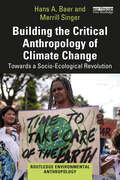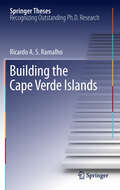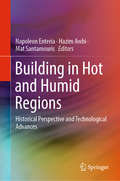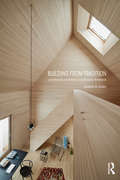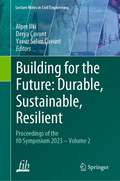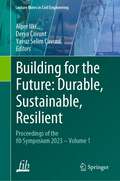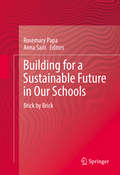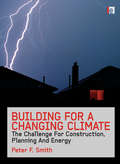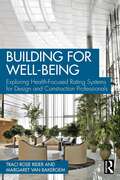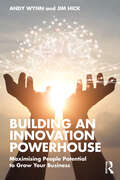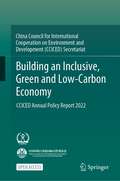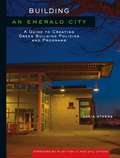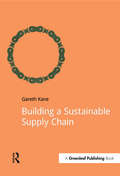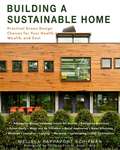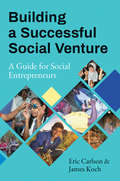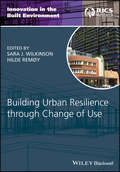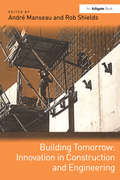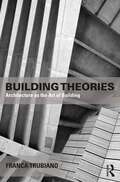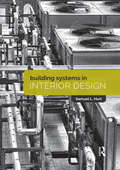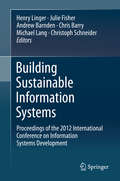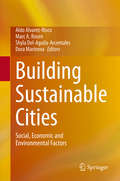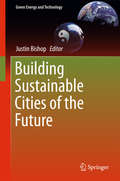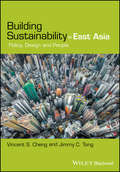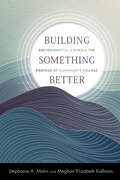- Table View
- List View
Building the Critical Anthropology of Climate Change: Towards a Socio-Ecological Revolution (Routledge Environmental Anthropology)
by Merrill Singer Hans A. BaerThis book applies a critical perspective to anthropogenic climate change and the global socio-ecological crisis.The book focuses on the critical anthropology of climate change by opening up a dialogue with the two main contending perspectives in the field, namely the cultural ecological and the cultural interpretive perspectives. Guided by these, the authors take a firm stance on the types of changes that are needed to sustain life on Earth as we know it. Within this framework, they explore issues of climate and social equity, the nature of the current era in Earth’s geohistory, the perspectives of the elite polluters driving climate change, and the regrettable contributions of anthropologists and other scholars to climate change. Engaging with perspectives from sociology, political science, and the geography of climate change, the book explores various approaches to thinking about and responding to the existential threat of an ever-warming climate. In doing so, it lays the foundation for a brave new sustainable world that is socially just, highly democratic, and climatically safe for humans and other species.This book will be of interest to researchers and students studying environmental anthropology, climate change, human geography, sociology, and political science.
Building the Cape Verde Islands (Springer Theses)
by Ricardo A. RamalhoHotspots are enigmatic surface features that are not easily explained in the framework of plate tectonics. Investigating their origin is the goal of this thesis, using field evidence collected in the Cape Verde Islands, a prominent hotspot archipelago in the eastern Atlantic Ocean. The approach taken is to document uplift of the islands relative to sea level and use the uplift features to test various models of hotspot development. Island uplift is thought to arise from the growth of the anomalously shallow seafloor on which the islands rest, known as the bathymetric swell, which is characteristic of hotspots. The work comprises a geological summary and detailed mapping of paleo sea level markers on Cape Verde. Isotopic dating of the markers shows that uplift on the islands over the last 6 Myr is up to 400 m, and that the uplift chronology varies among islands. Two processes act to raise the Cape Verde Islands. The dominant process is one that is local to individual islands. The regional, swell-related component is smaller, and possibly episodic. The observations provide strong constraints on swell development and on hotspot models.
Building on Borrowed Time: Rising Seas and Failing Infrastructure in Semarang
by Lukas LeyA timely ethnography of how Indonesia&’s coastal dwellers inhabit the &“chronic present&” of a slow-motion natural disaster Ice caps are melting, seas are rising, and densely populated cities worldwide are threatened by floodwaters, especially in Southeast Asia. Building on Borrowed Time is a timely and powerful ethnography of how people in Semarang, Indonesia, on the north coast of Java, are dealing with this global warming–driven existential challenge. In addition to antiflooding infrastructure breaking down, vast areas of cities like Semarang and Jakarta are rapidly sinking, affecting the very foundations of urban life: toxic water oozes through the floors of houses, bridges are submerged, traffic is interrupted. As Lukas Ley shows, the residents of Semarang are constantly engaged in maintaining their homes and streets, trying to live through a slow-motion disaster shaped by the interacting temporalities of infrastructural failure, ecological deterioration, and urban development. He casts this predicament through the temporal lens of a &“meantime,&” a managerial response that means a constant enduring of the present rather than progress toward a better future—a &“chronic present.&” Building on Borrowed Time takes us to a place where a flood crisis has already arrived—where everyday residents are not waiting for the effects of climate change but are in fact already living with it—and shows that life in coastal Southeast Asia is defined not by the temporality of climate science but by the lived experience of tidal flooding.
Building in Hot and Humid Regions: Historical Perspective and Technological Advances
by Napoleon Enteria Hazim Awbi Mat SantamourisThis book presents an in-depth analysis covering climatic and weather conditions, house and building development history, construction methods and technologies, and environmental conditions. It provides relevant house and building information and highlights recent advances in hot and humid regions, as well as developments in other regions that are relevant to hot and humid climates. The countries in hot and humid regions, which include the tropical countries, the Middle Eastern countries around the Mediterranean, and many countries of Central Asia and Africa, are home to some of the most challenging conditions in the world in terms of house and building design and construction, and in terms of maintaining indoor thermal comfort and air quality in an energy-efficient way. The book’s respective chapters, prepared by expert contributors, cover essential concepts, designs, and construction methodologies for houses and commercial buildings. As such, the book offers a valuable resource for undergraduate and graduate students in architecture and engineering, house and building designers, and building sciences researchers. Building contractors, manufacturers and distributors of building equipment and devices, and government policymakers and legislators will also benefit from the information provided in this book.
Building from Tradition: Local Materials and Methods in Contemporary Architecture
by Elizabeth M. GoldenBuilding from Tradition examines the recent resurgence of interest in the handmade building and the use of local and renewable materials in contemporary construction. In the past, raw materials were shaped to provide shelter and to accommodate the cultural, social, and economic needs of individuals and communities. This is still true today as architects, engineers, and builders turn once again to local resources and methods, not simply for constructing buildings, but also as a strategy for supporting social engagement, sustainable development, and cultural continuity. Building from Tradition features global case studies that allow readers to understand how building practices—developed and refined by previous generations—continue to be adapted to suit a broad range of cultural and environmental contexts. The book provides: • a survey of historical and technical information about geologic and plant-based materials such as: stone, earth, reed and grass, wood, and bamboo; • 24 detailed case studies examining the disadvantages and benefits to using traditional materials and methods and how they are currently being integrated with contemporary construction practices.
Building for the Future: Proceedings of the fib Symposium 2023 - Volume 2 (Lecture Notes in Civil Engineering #350)
by Alper Ilki Derya Çavunt Yavuz Selim ÇavuntThis book presents the proceedings of the fib Symposium “Building for the future: Durable, Sustainable, Resilient”, held in Istanbul, Turkey, on 5–7 June 2023. The book covers topics such as concrete and innovative materials, structural performance and design, construction methods and management, and outstanding structures. fib (The International Federation for Structural Concrete) is a not-for-profit association whose mission is to develop at an international level the study of scientific and practical matters capable of advancing the technical, economic, aesthetic, and environmental performance of concrete construction.
Building for the Future: Proceedings of the fib Symposium 2023 - Volume 1 (Lecture Notes in Civil Engineering #349)
by Alper Ilki Derya Çavunt Yavuz Selim ÇavuntThis book presents the proceedings of the fib Symposium “Building for the future: Durable, Sustainable, Resilient”, held in Istanbul, Turkey, on 5–7 June 2023. The book covers topics such as concrete and innovative materials, structural performance and design, construction methods and management, and outstanding structures. fib (The International Federation for Structural Concrete) is a not-for-profit association whose mission is to develop at an international level the study of scientific and practical matters capable of advancing the technical, economic, aesthetic, and environmental performance of concrete construction.
Building for a Sustainable Future in Our Schools: Brick by Brick
by Rosemary Papa Anna SaitiThis book explores how educators can transform improvements from the dynamic process of teaching into far-reaching, sustainable reforms that can secure a more prosperous future for students and the world they inhabit. It establishes the role of leadership in educational sustainability and highlights methods of creating sustainable educational reforms. The authors emphasize the importance of implementing ethical and moral values in teaching sustainable practices, and discuss the critical relationship between the classroom and the local community and policies protecting planet earth. Furthermore, through the inclusion of research and case studies drawn from countries across the world, this valuable resource demonstrates how transformational leadership practices can contribute to a culture of sustainability in all classrooms, pre-K through university. Among the topics covered: - Social Capital Dimensions: Social Justice, Morality, and the Common Good - Classroom and Community Partners: The Ethics and Morality Inherent in Sustainable Practices - Developing a Culture for Sustainability in Educational Organisations and in Partnerships, i. e. , Across Disciplines and Communities - Understanding Leadership Practices in a Sustainable School Model: A Case Study from Turkey Educators, education researchers, and policymakers in education will findBuilding for a Sustainable Future in Our Schools: Brick by Brick to be a useful tool in understanding the critical role of education in sustainable development encouraging complementary relationships between humans and our earth.
Building for a Changing Climate: The Challenge for Construction, Planning and Energy
by Peter F. SmithThere is now a practically universal consensus that our climate is changing rapidly, and as a direct result of human activities. While there is extensive debate about what we can do to mitigate the damage we are causing, it is becoming increasingly clear that a large part of our resources will have to be directed towards adapting to new climatic conditions, with talk of survivability replacing sustainability as the new and most pressing priority. Nowhere is this more evident than in the built environment – the stage on which our most important interactions with climatic conditions are played out. In this frank yet pervasively positive book, sustainable architecture guru Peter Smith lays out his vision of how things are likely to change, and what those concerned with the planning, design and construction of the places we live and work can and must do to avert the worst impacts. Beginning with the background to the science and discussion of the widely feared graver risks not addressed by the politically driven IPCC reports, he moves on to examine the challenges we will face and to propose practical responses based on real world experiences and case studies taking in flood and severe weather protection, energy efficient retrofitting, distributed power generation and the potential for affordable zero carbon homes. He ends with a wider discussion of options for future energy provision. This will be a provocative, persuasive and – crucially – practical read for anyone concerned with the measures we must take now to ensure a climate-proofed future for humanity.
Building for Well-Being: Exploring Health-Focused Rating Systems for Design and Construction Professionals
by Traci Rose Rider Margaret van BakergemBuilding for Well-Being is the first introduction to health-focused building standards for design and construction professionals. More than a summary of the state of the field, this practical resource guides designers, builders, developers, and owners through considerations for incorporating WELL®, Fitwel®, and other systems from the planning phase to ground-breaking and beyond. Side-by-side comparisons of established and emerging health-focused standards empower building professionals to select the most appropriate certifications for their projects. Drawing on the authors’ backgrounds in sustainable design and public health, chapters on the evolution of the green building movement and the relationship between health and the built environment provide vital context for understanding health-focused standards and certifications. The final chapter looks toward the future of health and the built environment.
Building an Innovation Powerhouse: Maximising People Potential to Grow Your Business
by Andy Wynn Jim HickIn Building an Innovation Powerhouse you will learn how to maximise the potential of people to grow your business. Authors Andy Wynn and Jim Hick dive deep into the most complex aspect of innovation and skilfully deconstruct the multi-dimensional complexities of working with people to reveal the secrets of how to handle the challenges of innovation. Building an Innovation Powerhouse uncovers the inner workings of industry giants, including Boston Consulting Group, Google, Hexcel, Kennametal, DuPont, CeramTec, Novartis, and many more, and explains exactly how these organisations and their leaders have motivated people to create a culture of innovation. A roadmap clearly sets out change in the following:1. Culture – how to guide an organisation to work holistically.2. Teams – how to ensure collaboration is laser-focused on business growth.3. Individuals – what people can do to become more creative and contribute to business success.4. Diversity – how to develop the right mix of skillsets, backgrounds and viewpoints.5. Leadership – what business leaders need to do to ensure that all levels of the business are heading in the right direction and delivering growth. Written with true insight by renowned leaders in their fields and enhanced by valuable case studies and contributions from numerous senior executives who have a real passion for stimulating innovation to drive business growth, this book is essential reading for businesses looking to transform into an innovation powerhouse.
Building an Inclusive, Green and Low-Carbon Economy: CCICED Annual Policy Report 2022
by CCICEDThis open access book introduces the major environmental green development issues from six major themes carbon neutrality, nature-based solution, watershed management and climate adaptation, BRI green development, sustainable food supply chain, ecosystem-based integrated ocean management focusing on the progress of China’s environment and development policies from 2021 accomplishments. It is based on the research outputs of CCICED in the year of 2021, which marks China’s start point of implementation of its 14th Five-Year Plan when world economy also strived to recover from the pandemic.
Building an Emerald City: A Guide to Creating Green Building Policies and Programs
by Lucia AthensIn 2000, Seattle, Washington, became the first U.S. city to officially adopt the U.S. Green Building Council's LEED (Leadership in Energy and Environmental Design) "Silver" standards for its own major construction projects. In the midst of a municipal building boom, it set new targets for building and remodeling to LEED guidelines. Its first LEED certified project, the Seattle Justice Center, was completed in 2002. The city is now home to one of the highest concentrations of LEED buildings in the world. Building an Emerald City is the story of how Seattle transformed itself into a leader in sustainable "green" building, written by one of the principal figures in that transformation. It is both a personal account--filled with the experiences and insights of an insider--and a guide for anyone who wants to bring about similar changes in any city. It includes "best practice" models from municipalities across the nation, supplemented by the contributions of "guest authors" who offer stories and tips from their own experiences in other cities. Intended as a "roadmap" for policy makers, public officials and representatives, large-scale builders and land developers, and green advocates of every stripe, Building an Emerald City is that rare book--one that is both inspirational and practical.
Building a Sustainable Supply Chain (Doshorts Ser.)
by Gareth KaneThe massive oil spill in the Gulf of Mexico in 2010 was not caused by BP, but by a contractor, yet BP got the blame. The toxic waste from the production of Apple products dumped in China in 2011 was not dumped by Apple, but by a supplier, yet Apple got the blame. The horsemeat found in beef burgers in 2013 was not added by Tesco, but by a supplier, yet Tesco got the blame. In all three cases, blame for the damage caused by suppliers floated up through the supply chain until it lodged with the big brand at the top. No longer can companies constrain their corporate responsibility within the factory fence, as that boundary is not recognized by outside observers. This situation is exacerbated by the fact that the majority of most organizations’ environmental footprint lies in their supply chain. This means that, to address the sustainability agenda in a meaningful way, they must tackle the impacts of their suppliers. Unfortunately this is a huge challenge as visibility and influence diminishes quickly as you start to work your way down through the layers of suppliers. This book gives a quick but comprehensive guide to the most effective techniques to help you proactively address environmental risks in the supply chain. It covers the following: the business case for a sustainable supply chain; supply chains and sustainability: the big picture; making supply chains sustainable: the fundamentals; basic techniques: the "hard yards" of green procurement; intermediate techniques: those requiring changes to operations and products/services; advanced techniques: changes to the business model and corporate philosophy.The book draws upon exclusive interviews with top sustainability practitioners along with the practical experiences of the author to provide real world examples at the cutting edge.
Building a Sustainable Home: Practical Green Design Choices for Your Health, Wealth, and Soul
by Schifman MelissaThe green building movement has produced hundreds of “how-to” books and websites that are filled with tips about green building and what homeowners should do to go green. While helpful and informative, when it comes to making actual purchasing and installation decisions, these books do not make it any easier for a homeowner to prioritize against a budget. The Sustainable Home serves this need, as it is written by a sustainability advisor and financial advisor who has personally directed the building and LEED certification of her own home. Here, she shares her knowledge and experience for others to use in their journey toward a greener way of living. Whether the reader is building a new home or doing a minor remodel, a homeowner needs a framework by which to guide their decisions. These decisions are based on values, and the author posits that there are really only three reasons to go green: For Our Health: By building more sustainably, we reduce our exposure to harmful chemicals and toxins. For Our Wealth: By building a more durable home and being more efficient with resources like water and electricity, we reduce our monthly utility bills and ongoing maintenance expenses. For Our Soul: Collectively doing the right thing for our planet does make a difference—and that is soul-nourishing. Learn the logistics of choosing windows, insulation, appliances, and lighting. Find out about FSC certified wood and about using reclaimed materials. Here is everything you need to make your home sustainable.
Building a Successful Social Venture: A Guide for Social Entrepreneurs
by Eric Carlson James KochThis is the first book on creating and running a social enterprise to combine theoretical discussions with current cases from around the world, filling a huge gap in the literature. It serves as an eminently practical blueprint for those who wish to build, sustain, and grow social ventures. Building a Successful Social Venture draws on Eric Carlson's and James Koch's pioneering work with the Global Social Benefit Institute, cofounded by Koch at Santa Clara University's Miller Center for Social Entrepreneurship. Since 2003, over 200 Silicon Valley executives have mentored more than 800 aspiring social entrepreneurs at the GSBI. It is this unparalleled real-world foundation that truly sets the book apart. Early versions of the book were used in both undergraduate and MBA classes.Part 1 of the book describes the assumptions that the GSBI model is based on: a bottom-up approach to social change, a focus on base-of-the-pyramid markets, and a specific approach to business planning developed by the GSBI. Part 2 presents the seven elements of the GSBI business planning process, and Part 3 lays out the keys to executing it. The book includes "Social Venture Snapshots" illustrating how different organizations have realized elements of the plan, as well as a wealth of checklists and exercises.Social ventures hold enormous promise to solve some of the world's most intractable problems. This book offers a tested framework for students, social entrepreneurs, and field researchers who wish to learn more about the application of business principles and theories of change for advancing social progress and creating a more just world.
Building Urban Resilience through Change of Use
by Sara J. Wilkinson Hilde RemøyDescribes all aspects of sustainable conversion adaptation of existing buildings and provides solutions for making urban settlements resilient to climate change This comprehensive book explores the potential to change the character of cities with residential conversion of office space in order to withstand the negative effects of climate change. It investigates the nature and extent of sustainable conversion in a number of global cities, as well as the political, economic, social, technological, environmental, and legal drivers and barriers to successful conversion. The book also identifies the key lessons learned through international comparisons with cases in the UK, US, Australia, and the Netherlands. Building Urban Resilience Through Change of Use covers the benefits and aspects of sustainable conversion adaptation through the whole lifecycle from inception, planning, and design, to procurement, construction, and management and operational issues. It illustrates and quantifies, through empirical research, the changes that have been achieved or delivered in sustainable conversion adaptation. The book gives an overview of all aspects of performance characteristics and the conversion adaptation of existing buildings. In the end, it enables planners to make more informed decisions about whether conversion adaptation is a good choice—and if so, which types of sustainability measures are best suited for projects. Provides detailed, empirical knowledge based on real-world research undertaken in five countries over three continents on both a citywide scale and on individual buildings Case studies and exemplars demonstrate the application of the knowledge in North and South America, Canada, Australia, New Zealand, and in Europe Addresses the key themes of technology, finance and procurement, and the regulatory framework The first research-based book to examine how to improve resilience to climate change through sustainable reuse of buildings, Building Urban Resilience Through Change of Use is a welcome book for researchers and academics involved in building surveying, urban development, and sustainability planning.
Building Tomorrow: Innovation in Construction and Engineering
by André ManseauIn the past decade construction and engineering have changed dramatically, with an explosion of innovative new approaches to construction and new methodologies. By bringing together economic, social and construction/engineering management perspectives, this book offers a unique and comprehensive survey of these approaches and techniques. It presents a history of studies in innovation in construction and engineering, and then presents the most recent models of innovation brokering and risk-management, based on complex project-based industries. Innovation is defined and competing theories are discussed in the light of operational issues. The book covers all aspects, including the importance of construction and engineering 'cultures' in the trades for successful project innovation. It also discusses the role of government and policy makers, the implications of rapid change for the building trades and skilled labour, and the difficulty of measuring innovation quantitatively.
Building Theories: Architecture as the Art of Building
by Franca TrubianoBuilding Theories speaks to the value of words in architecture. It addresses the author’s fascination with the voices of architects, engineers, builders, and craftspeople whose ideas about building have been captured in text. It discusses the content of treatises, essays, articles, and letters by those who have been, throughout history, committed to the art of building. In this, Building Theories argues for the return of a practice of architectural theory that is set amongst building, buildings, and builders. This journey of close reading reinterprets the words of Vitruvius, Alberti, de L’Orme, Le Camus de Mézières, Boullée, Laugier, Rondelet, Semper, Viollet-le-Duc, Hübsch, Bötticher, Berlage, Muthesius, Wagner, Behrendt, Gropius, and Arup. With chapters dedicated to texts from antiquity, the Renaissance, and the nineteenth century, and with a critical eye on architectural theory popularized in the Anglo-Saxon world post-1968, readers are introduced to a wider, more inclusive definition of architectural ideas. Building Theories considers how contemporary scholarship has steered away from the topic of building in its reluctance to admit that both design and construction are central to its concerns. In response, it argues for a realignment of architecture with the concept of techné, with a dual commitment to fabrica e ratio, with a productive return to l’art de bien bastir, with the accurate translation of the term Baukunst, and with an appeal to the architect’s ‘composite mind.’ Students, practitioners, and educators will identify in Building Theories ways of thinking that strive for the integration of design with construction; reject the supposed primacy of the former over the latter; recognize how aesthetics are an insufficient scaffold for subtending the subject of architectural ethics; and accept, without reservation, that material transformations have always been at the origins of built form.
Building Systems in Interior Design
by Samuel L. Hurt<p>Building Systems in Interior Design takes an entirely new approach to teaching this essential topic for Architects, Designers and Building Engineers. Written to prepare students for the real world and packed with practical examples, the book will foster an understanding of specific issues that are critical to those features of technical systems that most directly affect design. The book stresses the ever-present nature of these systems: they are everywhere, all the time. <p>Taking a design oriented view, it outlines what can and cannot be done, and provides the student with the know-how and confidence to defend and promote their design intent when working with other industry professionals. <p>Covering lighting, HVAC, plumbing and much more, the book is packed with key features to aid learning including: <p> <li>Numerous illustrations, plans and photographs <li>Key terms defined in an extensive glossary <li>Chapter introductions that identify key concepts and chapter summaries to re-visit those key concepts <li>Professional design tips <li>And a detailed bibliography and web links</li> <p> <p>This book is not only a core text for interior design, building systems engineering and architecture students but will become an essential working reference through their careers.</p>
Building Sustainable Information Systems: Proceedings Of The 2012 International Conference On Information Systems Development
by Michael Lang Christoph Schneider Chris Barry Henry Linger Julie Fisher Andrew BarndenInformation Systems (IS) as a discipline draws on diverse areas including, technology, organisational theory, management and social science. The field is recognized as very broad and encompassing many themes and areas. However, the development of artefacts, or information systems development (ISD), in the broadest sense, is a central concern of the discipline. Significantly, ISD impacts on the organisational and societal contexts through the use of the artefacts constructed by the development. Today, that impact also needs to be evaluated in terms of its effects on the environment. Sustainable, or "green," IT is a catch-all term used to describe the development, manufacture, management, use and disposal of ICT in a way that minimizes damage to the environment. As a result, the term has many different meanings, depending on the role assumed in the life span of the ICT artefact. The theme of the proposed work is to critically examine the whole range of issues around ISD from the perspective of sustainability. Sustainable IT is an emerging theme in academic research and industry practice in response to an individual concern for the environment and the embryonic regulatory environments being enacted globally to address the environmental impact of ICT. In this work we intend to bring together in one volume the diverse research around the development of sustainable IS.
Building Sustainable Cities: Social, Economic and Environmental Factors
by Marc A. Rosen Aldo Alvarez-Risco Dora Marinova Shyla Del-Aguila-ArcentalesThis book describes a broad view of sustainability as a crucial factor for the success of its implementation. Not only the environmental aspects of the sustainable cities´ development are reviewed but the economic and social aspects of it, as highlighted in the UN Sustainable Development Goal 11 (make cities and human settlements inclusive, safe, resilient and sustainable).Nowadays, researchers, students, and stakeholders are highly involved in sustainability issues. Because of this, they need a guiding document to help them develop and implement sustainability programs at the level of companies and institutions.In this book, the authors discuss and explain basic concepts of sustainability-related to social, economic and environmental aspects, as well as strategies for its implementation.
Building Sustainable Cities of the Future (Green Energy and Technology)
by Justin BishopThis book draws upon the expertise of academic researchers, urban planners and architects to explore the challenge of building the sustainable cities of the future. It addresses this challenge by considering current cities and those of the near future, and creates a picture of the sustainable city from the bottom up. Individual chapters cover topics such as transport, energy supply, sustainable urbanism and promoting social equality in large infrastructure projects. Real-world examples are presented to illustrate how systems thinking is used to integrate different components of a city so as to ensure that the whole is more sustainable than its parts. Written in an accessible style, this book is intended for general readers as much as it is for students and researchers interested in sustainable cities and related topics. It is also ideal for urban planners seeking best-practice guidelines for sustainable urban development.
Building Sustainability in East Asia: Policy, Design and People
by Jimmy C. Tong Vincent S. ChengBuilding Sustainability in East Asia: Policy, Design and People illustrates the holistic approaches and individual strategies to building sustainability that have been implemented in construction projects in Asia. Top-down and bottom-up approaches (from formulating policy to constructing individual buildings) are effective in terms of the sustainable development of cities, and this book covers both, illustrated with a range of case study developments.
Building Something Better: Environmental Crises and the Promise of Community Change (Nature, Society, and Culture)
by Stephanie A. Malin Meghan Elizabeth KallmanAs the turmoil of interlinked crises unfolds across the world—from climate change to growing inequality to the rise of authoritarian governments—social scientists examine what is happening and why. Can communities devise alternatives to the systems that are doing so much harm to the planet and people? Sociologists Stephanie A. Malin and Meghan Elizbeth Kallman offer a clear, accessible volume that demonstrates the ways that communities adapt in the face of crises and explains that sociology can help us understand how and why they do this challenging work. Tackling neoliberalism head-on, these communities are making big changes by crafting distributive and regenerative systems that depart from capitalist approaches. The vivid case studies presented range from activist water protectors to hemp farmers to renewable energy cooperatives led by Indigenous peoples and nations. Alongside these studies, Malin and Kallman present incisive critiques of colonialism, extractive capitalism, and neoliberalism, while demonstrating how sociology’s own disciplinary traditions have been complicit with those ideologies—and must expand beyond them. Showing that it is possible to challenge social inequality and environmental degradation by refusing to continue business-as-usual, Building Something Better offers both a call to action and a dose of hope in a time of crises.
